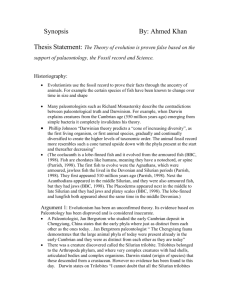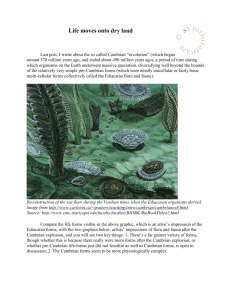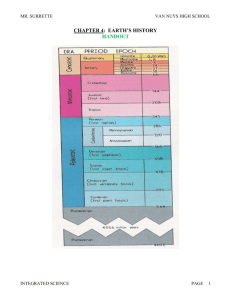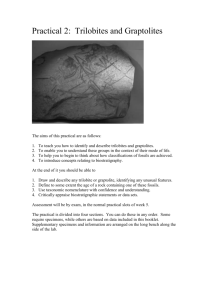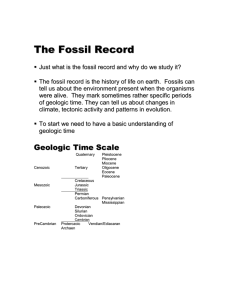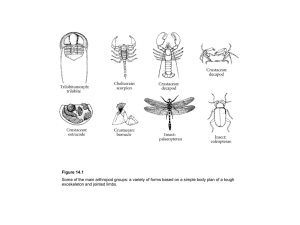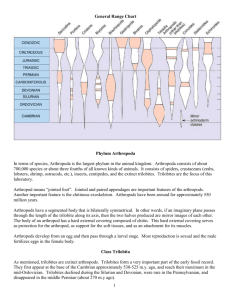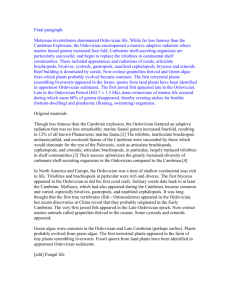Examining the Fossil Record
advertisement
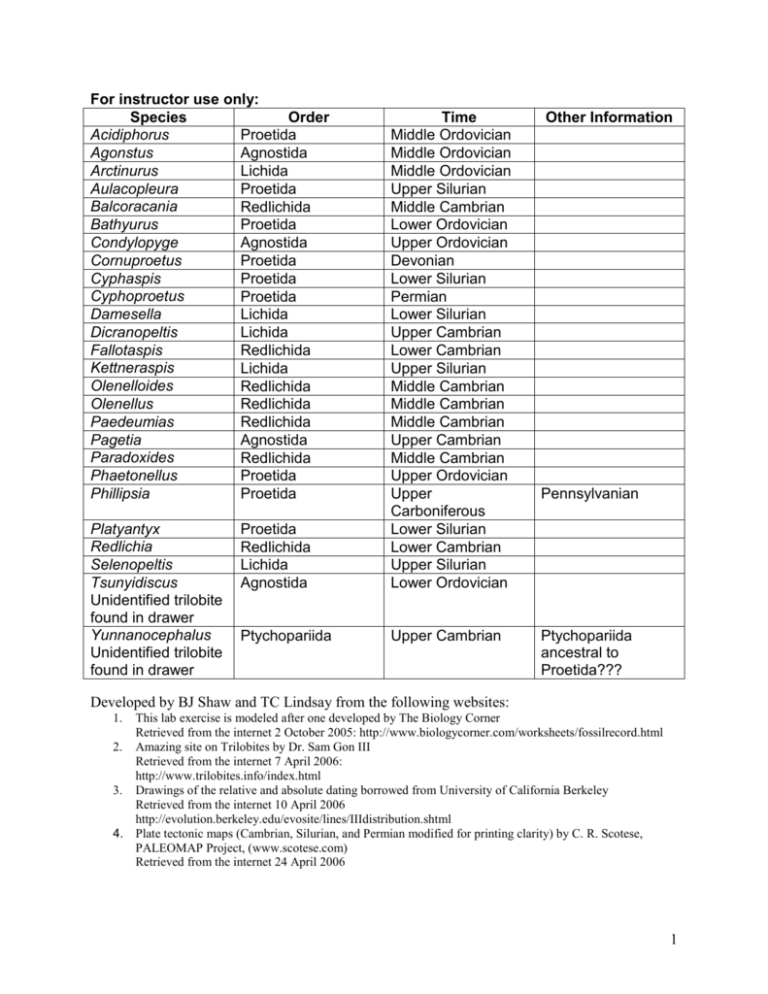
For instructor use only: Species Order Acidiphorus Proetida Agonstus Agnostida Arctinurus Lichida Aulacopleura Proetida Balcoracania Redlichida Bathyurus Proetida Condylopyge Agnostida Cornuproetus Proetida Cyphaspis Proetida Cyphoproetus Proetida Damesella Lichida Dicranopeltis Lichida Fallotaspis Redlichida Kettneraspis Lichida Olenelloides Redlichida Olenellus Redlichida Paedeumias Redlichida Pagetia Agnostida Paradoxides Redlichida Phaetonellus Proetida Phillipsia Proetida Platyantyx Redlichia Selenopeltis Tsunyidiscus Unidentified trilobite found in drawer Yunnanocephalus Unidentified trilobite found in drawer Proetida Redlichida Lichida Agnostida Time Middle Ordovician Middle Ordovician Middle Ordovician Upper Silurian Middle Cambrian Lower Ordovician Upper Ordovician Devonian Lower Silurian Permian Lower Silurian Upper Cambrian Lower Cambrian Upper Silurian Middle Cambrian Middle Cambrian Middle Cambrian Upper Cambrian Middle Cambrian Upper Ordovician Upper Carboniferous Lower Silurian Lower Cambrian Upper Silurian Lower Ordovician Ptychopariida Upper Cambrian Other Information Pennsylvanian Ptychopariida ancestral to Proetida??? Developed by BJ Shaw and TC Lindsay from the following websites: 1. This lab exercise is modeled after one developed by The Biology Corner Retrieved from the internet 2 October 2005: http://www.biologycorner.com/worksheets/fossilrecord.html 2. Amazing site on Trilobites by Dr. Sam Gon III Retrieved from the internet 7 April 2006: http://www.trilobites.info/index.html 3. Drawings of the relative and absolute dating borrowed from University of California Berkeley Retrieved from the internet 10 April 2006 http://evolution.berkeley.edu/evosite/lines/IIIdistribution.shtml 4. Plate tectonic maps (Cambrian, Silurian, and Permian modified for printing clarity) by C. R. Scotese, PALEOMAP Project, (www.scotese.com) Retrieved from the internet 24 April 2006 1 For instructor use only: For 2 Examining the Trilobite Fossil Record Objectives: Students will produce a to-scale time converted to distance model of the Paleozoic analyze characteristics of fossil Trilobites compare placement of fossils and determine relative ages develop a model evolutionary tree based on the morphology and age of fossils Background: Fossils Fossils are the remains or traces of organisms that lived in the past. When scientists find fossils, they carefully note where the fossils are located, both on Earth (i.e. Burgess Shale, British Columbia, Canada) and stata or layer of earth, for analysis of the age of the fossil. A geologic concept called superposition states that the layers of earth at the surface are younger than layers of earth below. For example, in the Grand Canyon, the rock that is the oldest is down by the river, and the youngest, most recent rock is located at the top of the canyon. Ages and Dating Absolute age is determined though radiometric dating and determining the layer of rock in which the fossil was found, and can have a rather small margin of error for the exact age. An example would be the K-T boundary, which ended the dinosaur reign 63.9 to 65.4 million years ago (MYA). That is a 1.5 million year or 2.3% margin of error. younger Dating of volcanic ash older Relative Dating Relative age cannot determine exactly how old a fossil is, but instead can give a range in which this fossil lived. For example, we find a fossil between two layers that have been radiometric dated 13.6 and 33.8 MYA. We can state with assurance that this fossil’s age is between 13.6 and 33.8 million years old. The age and morphologies (shapes and forms) of fossils can be used to place fossils in sequences that often show patterns of changes that have occurred over time. This relationship can be depicted in either a cladogram or an evolutionary tree (also known as a phylogenetic tree). 1 Gradualism and Punctuated Equilibrium There are two major hypotheses on how evolution takes place (and both hypotheses are accepted to explain the two different observations made in the fossil record – in other words, they are not mutually exclusive): gradualism and punctuated equilibrium. Gradualism suggests that organisms evolve through a process of slow and constant change. For instance, an organism that shows a fossil record of gradually increased size in small steps, or an organism that shows a gradual loss of a structure. Punctuated equilibrium suggests that species evolve very rapidly and then stay the same for a large period of time. This rapid change is attributed to a mutation in a few essential genes. The sudden appearance of new structures could be explained by punctuated equilibrium. Gradualism: organism’s body segments shorten and fuse. Punctuated equilibrium: organism head shape changes, then loss of body segment. Speciation The fossil record cannot accurately determine when one species becomes another species. However, two hypotheses regarding speciation also exist. Phyletic speciation suggests that abrupt mutations in a few regulatory genes occur after a species has existed for a long period of time. This mutation results in the entire species shifting to a new species. Phyletic speciation would also relate to the Punctuated Equilibrium hypothesis regarding evolution. Divergent speciation suggests that a gradual accumulation of small genetic changes results in subpopulation of a species that eventually accumulate so many changes that the subpopulations become different species. This hypothesis would coincide with the gradualism model of evolution. Most evolutionary biologists accept that a combination of the two models has affected the evolution of species over time. Phyletic Speciation: Species A Species B Species C Species A Divergent Speciation: Species A Species A Trilobites: Introduction Trilobites are Class Trilobita in the Phylum Arthropoda, together with insects, spiders, centipedes, millipedes, crustaceans, and some lesser known animals. Trilobites are first found in 542 million year old rocks of the lower Cambrian. They are well preserved because they had calcified exoskeletons. They increased in numbers of species through the Ordovician (488-444 MYA) to 46 Families. The number of Families suddenly dropped at the end of the Ordovician, and in the Sulurian, only 13 Families remained. By the Permian (299-251 MYA) only 2 2 Families remained when they entirely went extinct at the Permo-Triassic Boundary. These remarkable animals diversified into 5000 genera, and over 15,000 described species. Trilobites survived for about 300 million years. Not bad, especially compared to humanoid’s appearance a paltry 6-7 million years, and Homo sapiens appearance less than 1 million years ago. Evolutionary Trends in Trilobites Reduced Segment Thoracocare Elongate Form Crotalocephalina Plesiomorphic Form Redlichia Increased Segments Balcoracania Transverse Form Harpillaenus 3 Morphology in Trilobites The name "trilobite" (meaning "three-lobed") is not based on the body sections cephalon, thorax and pygidium, but rather on the three longitudinal lobes: a central axial lobe, and two symmetrical pleural lobes that flank the axis. The trilobite body is divided into three major sections, a cephalon with eyes, mouthparts and sensory organs such as antennae, a thorax of multiple similar segments (that allowed some species to roll into a defensive ball), and a pygidium, or tail section. Rostral plate Anterior branch of the facial suture Rostral suture Connective suture Cephalic doublure Hypostome Postenor branch of the facial suture Pleural doublure Pygidial doublure 4 Pagetiidae ORDER AGNOSTIDA Pagetia Introduction: Small trilobites (usually only a few mm long) with cephalon and pygidium strongly similar in outline and size. Cephalon: cephalic shield with deeply parabolic outline, maximum width usually anterior of genal angle, border convex; glabella fusiform, widest at base, glabellar segmentation highly variable, sometimes complex, but in some species entirely effaced; most species eyeless; sometimes specialized with ribbon-like wings; rostral plate lacking. Thorax: segments 2 (Agnostina) or 3 (some Eodiscina), axis typically broad. Pygidium: strongly matching cephalic margin. Occurrence: Lower Cambrian to Upper Ordovician. ORDER LICHIDA Introduction: typically spiny with densely granulate or tuberculate exoskeletons. Cephalon: glabella broad, large, extending to anterior border, lobation simple (Odontopleuroidea) to complex, with fused lateral and glabellar lobes (Lichoidea); eyes typically present. Thorax: variable, 8-13 segments, usually spine-tipped, sometimes with distinctive spines (e.g., Odontopleuroidea). Pygidium: typically isopygous to macropygous, but sometimes short (e.g., Odontopleuroidea), often longer than wide, often with 3 pairs of furrowed pleurae, typically ending in spinose tips. Occurrence: Middle Cambrian to Upper Devonian 5 ORDER PROETIDA Introduction: typically small trilobites, exoskeleton sometimes with pits or small tubercles. The last of the trilobites was of this order (Phillipsiidae). Cephalon: opisthoparian sutures; glabella large, vaulted, well-defined, typically narrowing forwards, typically 4 pairs of glabellar furrows with posterior-most pair longest and deepest, those anterior shorter and fainter; eyes, usually present, holochroal, often large, convex; rostral plate narrow and backward tapering; long hypostome; typically with genal spines. Thorax: 8 – 22 (typically 10) segments, tips variable, blunt to long-spined. Pygidium: micropygous to subisopygous, often spineless, and usually with 4 – 10+ distinct pleural furrows. Occurrence: Lower Ordovician to Upper Permian ORDER REDLICHIIDA Introduction: Primitive trilobites with numerous thoracic segments with spinose tips. Cephalon: large and semicircular; glabella typically long, well-segmented, tapering or expanding forwards; genal spines typically present, strong, usually continued from a narrow, tubular cephalic border; eyes typically large, crescentic, with large, inflated palpebral lobe ridges running toward front of glabella (anterior of S3); eye ridge may be subdivided; hypostome typically conterminant, usually very wide rostral plate present. Thorax: with numerous segments (up to 60+), pleurae usually with spinose tips; may be subdivided into prothorax and opisthothorax. Pygidium: typically tiny (micropygous), one or very few segments. Occurrence: Cambrian Materials (per team of 2-4 students): Butcher paper cut into 1.5 m segments Color pencils Black marker Meter stick Tape or glue stick Copy of lab Scissors Masking tape 6 Procedure: We are going to examine the phylogenetic relationships of selected species from 4 (out of 9 total) orders of trilobites. As a class, discuss trilobites, when they are found, how they are found, their relationship to extant (living) species, etc. All trilobites are extinct, but during their existence, they were extremely successful. 1. The diagram you are creating requires a large space. To create your workspace, cut butcher paper into 1.63 meters (5.5 ft) lengths, one per team. (Note, Upper and Early are interchangeable terms, as are Lower and Late. One refers to strata and the other time.) Time Period Trilobites (20 cm wide) (remaining width of paper and 5 cm deep) Permian This space is 20.5 cm deep 286 — 245 MYA Carboniferous Upper (Pennsylvanian) 320 — 286 MYA Carboniferous Lower (Mississippian) 360 — 320 MYA Devonian Upper 374 — 360 MYA Devonian Middle 387 — 374 MYA Devonian Lower 408 — 387 MYA Silurian Upper 421 — 408 MYA Silurian Lower 438 — 421 MYA Ordovician Upper 458 — 438 MYA Ordovician Middle 478 — 458 MYA Ordovician Lower 505 — 478 MYA Cambrian Upper 523 — 505 MYA Cambrian Middle 540 — 523 MYA Cambrian Lower 570 — 540 MYA This space is 17 cm deep This space is 20 cm deep This space is 7 cm deep This space is 6.5 cm deep This space is 10.5 cm deep This space is 6.5cm deep This space is 8.5 cm deep This space is 10 cm deep This space is 10 cm deep This space is 13.5 cm deep This space is 9 cm deep This space is 8.5 cm deep This space is 15 cm deep 2. Use the meter stick to draw the chart on your workspace as depicted above. Each of the time periods will be a different size depending on the length of time. Each 5mm (½cm) equals 1 million years. 3. The "fossils" you will work with are paper representations of real trilobites. Each trilobite on your sheet is marked with a time period. Cut out on the border so that the picture trilobite together with the time period and subdivision. 4. Color the 3 body sections (cephalon, thorax, and pygidium) with different colors and count the number of segments. 7 5. Place the trilobites in the correct time period. Examine and group the trilobites with similar characteristics (refer to order characteristics on pages 5 – 6. Once all the trilobites have been placed correctly according to time and morphology, tape or glue the fossils in place. 6. Assume the oldest trilobite is the ancestral form to all other trilobites. Connect the trilobites with phylogenetic lines of how they may have speciated. This is a model of speciation. Analysis: 1. Give a brief description of the evolutionary changes that occurred in the organism. 2. During which time period did the fossils differentiate into two or more branches? 3. Explain how the chart illustrates both punctuated equilibrium and gradualism. Use specific fossils from the chart to support your answer. 4. Making the assumption that each fossil represents a separate species. Explain how the chart illustrates divergent and phyletic speciation. Use specific fossils from the chart to support your answer. 5. Define the following terms: a. morphology b. fossil c. phylogenetic tree 6. While working in a museum, you find these two unidentified trilobites. Develop a list of their characteristics. Where would you place them on your chart and why? Species 1 Species 2 "Fossils" are on the following page. Extensions: Math – Students complete a to-scale time converted to distance model of geologic time. What is the percentage of geologic time that was the Hadean, Archean, Proterozoic, and Phanerozoic (the Eons), and within the Phanerozoic, divide into Paleozoic, Mesozoic, and Cenozoic (the Eras). The Eras can be further divided into the Periods (for example, Cambrian, Ordovician, etc.) Periods are further divided into Epochs. Math and Science – Students transform 1 million and 1 billion years into other models (i.e. use a world map and transform 1 million years to 1 mile, or calculate how old students will be when they are 1 million and 1 billion seconds old) Writing – Assign a report about a Phyla or Class from the Paleozoic. 8 Acidiphorus Mid Ordovician Balcoracania Mid Cambrian Cyphaspis Lower Silurian Agnostus Mid-Ordovician Bathyurus Lower Ordovician Cyphoproetus Permian Arctinurus Mid Ordovician Condylopyge Lower Ordovician Damesella Lower Silurian Aulacopleura Upper Silurian Cornuproetus Mid Devonian Dicranopeltis Upper Cambrian 9 Back Page of Trilobite Pictures 10 Fallotaspis Lower Cambrian Paedeumias Mid Cambrian Phillipsia Pennsylvanian Kettneraspis Upper Silurian Pagetia Upper Cambrian Platyantyx Lower Silurian Olenelloides Mid Cambrian Paradoxides Mid Cambrian Redlichia Lower Cambrian Olenellus Mid Cambrian Phaetonellus Upper Ordovician Selenopeltis Upper Silurian (Upper Carboniferous) 11 Back Page of Trilobite Pictures 12
